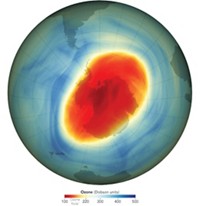Advertisement
Grab your lab coat. Let's get started
Welcome!
Welcome!
Create an account below to get 6 C&EN articles per month, receive newsletters and more - all free.
It seems this is your first time logging in online. Please enter the following information to continue.
As an ACS member you automatically get access to this site. All we need is few more details to create your reading experience.
Not you? Sign in with a different account.
Not you? Sign in with a different account.
ERROR 1
ERROR 1
ERROR 2
ERROR 2
ERROR 2
ERROR 2
ERROR 2
Password and Confirm password must match.
If you have an ACS member number, please enter it here so we can link this account to your membership. (optional)
ERROR 2
ACS values your privacy. By submitting your information, you are gaining access to C&EN and subscribing to our weekly newsletter. We use the information you provide to make your reading experience better, and we will never sell your data to third party members.
Environment
Earth’s Average Temperature Continues To Rise
Global Change: Satellite data shows record-breaking warmth continues
by Steven K. Gibb
August 24, 2015

Satellite data show July was the warmest month ever on record worldwide and 2015 the hottest year thus far, the U.S. National Oceanic and Atmospheric Administration (NOAA) says.
The temperature findings parallel the ongoing trend of increasing concentrations of greenhouse gases in the atmosphere.
NOAA also found increases in the frequency and intensity of heat waves in July, particularly in Europe and the Middle East. Global average temperatures were exacerbated by the recurrence of the El Niño phenomenon in the Pacific Ocean, which brings warmer waters to the surface. The recurrence began in June and has an 80% chance of continuing through the spring of 2016, according to NOAA.
NOAA also compared global average temperatures with historical records and found that the first seven months of 2015 were 0.85 °C above the 20th-century average global temperature.
July had a monthly combined average temperature over land and ocean surfaces of 16.61 °C, an all-time high since record keeping began in 1880, NOAA says.
According to a new climate report from NOAA, “The July temperature is currently increasing at an average rate of 0.65 °C (1.17 °F) per century.”
International diplomats will be negotiating a new climate pact in Paris in three months with the international policy goal of limiting warming to below 2 °C by 2100.




Join the conversation
Contact the reporter
Submit a Letter to the Editor for publication
Engage with us on Twitter